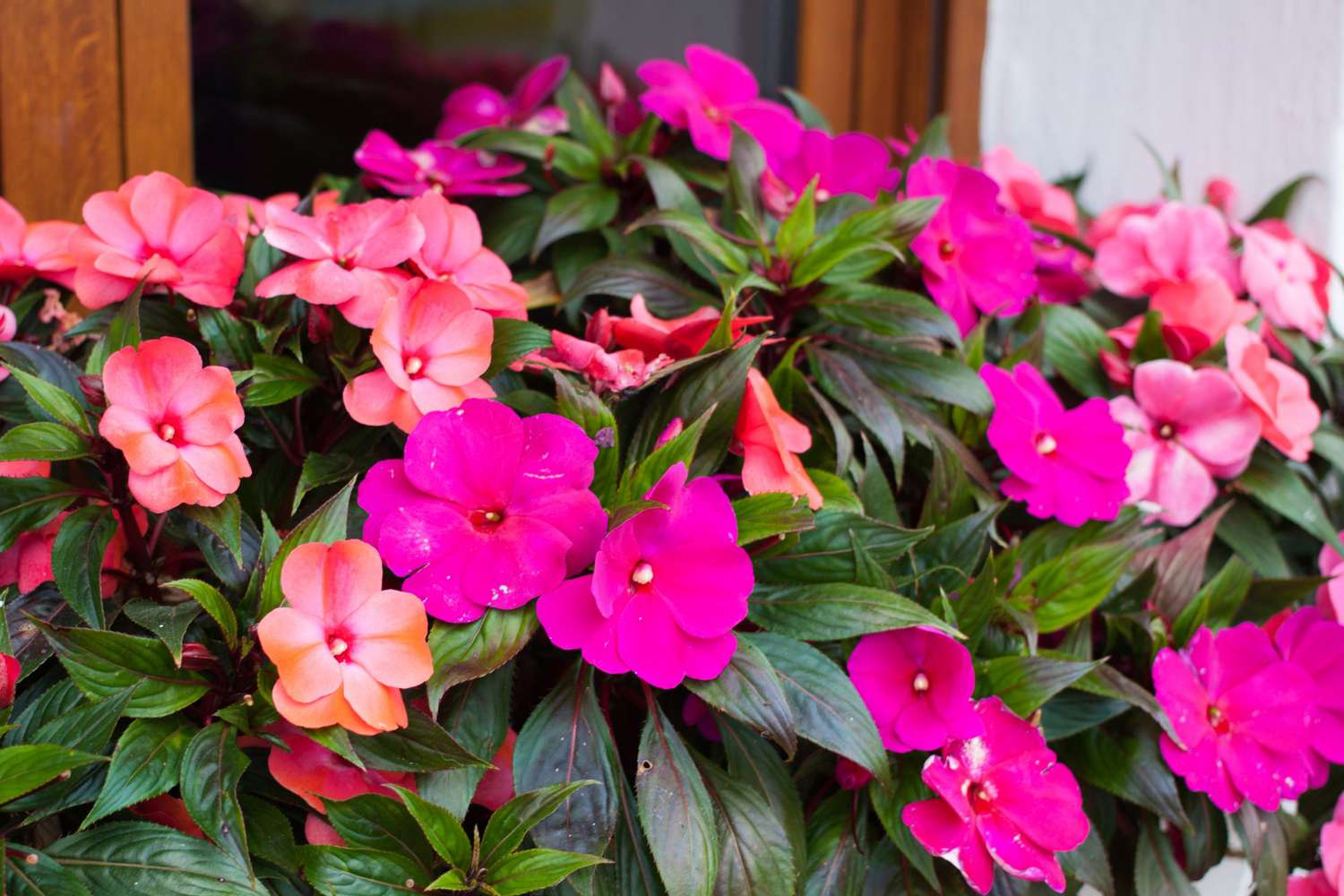There exists a multitude of flowers that have the ability to captivate hummingbirds, but it is crucial to discover plants that can endure and flourish in the specific weather conditions of your region. In cases where the temperature becomes excessively hot or cold, these plants may wither away or fail to grow sufficiently, resulting in the absence of the necessary flowers that hummingbirds rely on for nectar collection.
To address this concern, the United States Department of Agriculture (USDA) has designed a plant hardiness zone map that divides the country into 13 distinct zones based on the average minimum temperature. Furthermore, within each state, different zones may be identified. The survival and growth of plants are influenced by these zones, as they can tolerate minimum temperatures but are unable to withstand extreme cold if it surpasses their threshold.
Ohio experiences cold winters and warm, pleasant summers, with a majority of the state falling within plant hardiness zone 6, although some areas lie within zone 5.
Additionally, plants can also face challenges with excessive heat. Consequently, the American Horticultural Society has devised a plant heat-zone map that illustrates the average number of days an area experiences temperatures exceeding 86 degrees Fahrenheit.
In the plant heat zone map, Ohio falls within zones 4 to 6, indicating that it is the cold winters rather than the heat that will primarily impact hummingbird plants in the region.
To ensure the suitability of these plants for Ohio’s cold and heat zones, thorough assessments have been conducted. This ensures that these plants not only possess exquisite flowers rich in nectar that hummingbirds adore but also possess the ability to thrive in Ohio’s unique weather conditions.
It is important to note that plants suitable for cold zone 6 might struggle to survive the colder winters in zone 5 of Ohio without adequate protection. Examples of such plants include fuchsia, Cypress vine, hibiscus, mimosa, and Abelia.
Therefore, it is highly recommended to cultivate as many of these flower varieties as possible to attract hummingbirds in Ohio.
Ohio Hummingbird Plants for Cold Zones 5 and 6:
1. Nasturtiums
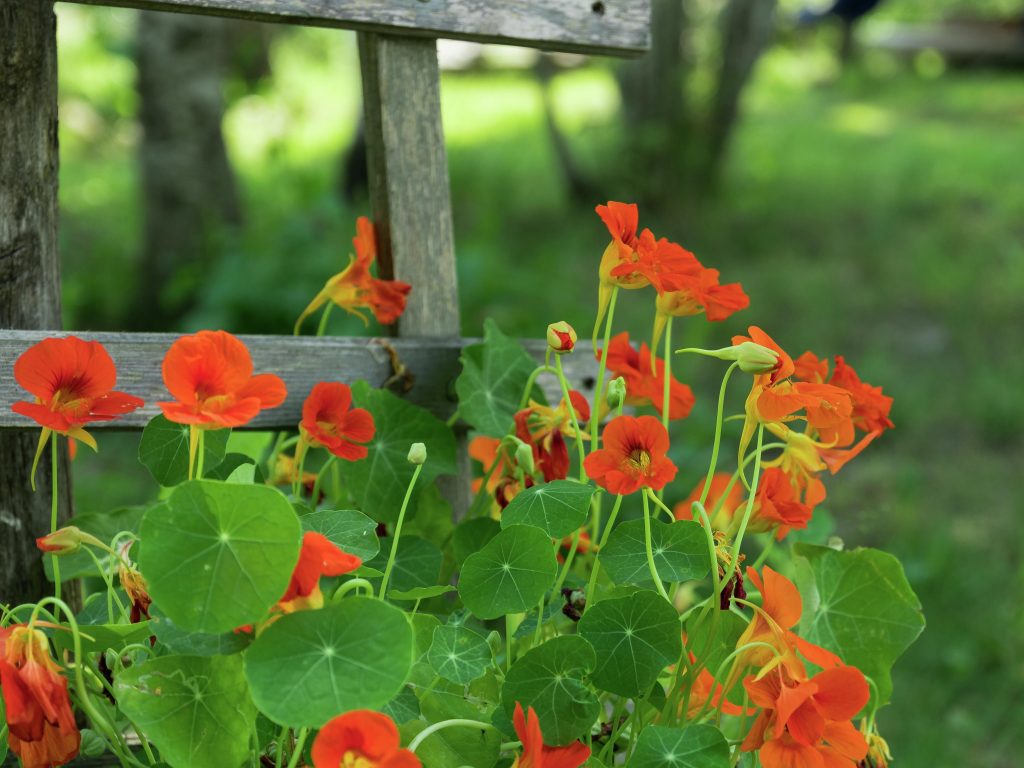
Nasturtiums are cascading edible flowers that prove ideal for creating hanging baskets to entice hummingbirds due to their nectar-rich blossoms and uniquely designed deep flowers.
Typically grown as annuals, they come in trailing or bushy varieties. Sow the seeds just after the final frosts have subsided, ensuring they receive adequate watering during the growing season and periodic deadheading.
Common Name: Nasturtiums
Scientific Name: Tropaeolum
Growing Zones: 2 – 11
Sun: Full
Soil: Well-drained
Colors: Red, orange, yellow, pink
Height: 1 – 10 feet
Spread: 1 – 3 feet
Plant Type: Annual
2. Zinnia
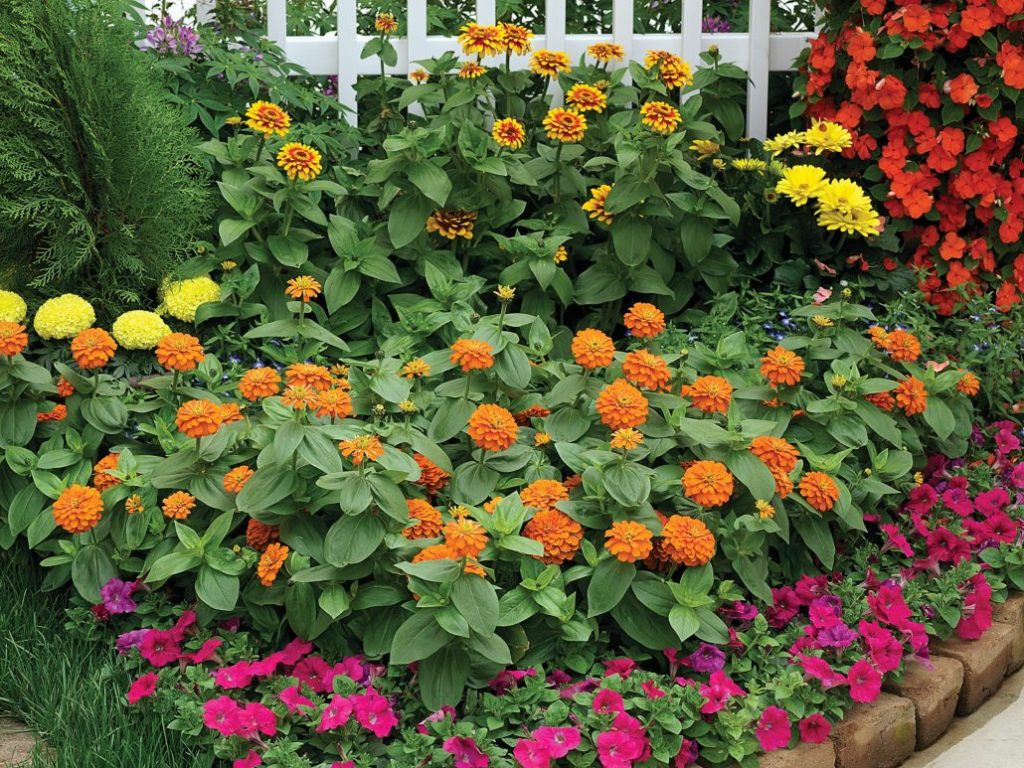
Zinnias are flowering shrubs indigenous to North America’s scrublands and dry grasslands. They belong to the Heliantheae genus, part of the extensive daisy family, Asteraceae.
Zinnias can be categorized into three main types based on their petal structure. Single-flowered zinnias possess a solitary row of petals with a visible center. Double-flowered zinnias consist of multiple rows of petals without a visible center, while semi-double-flowered zinnias feature numerous rows with visible centers.
Among the zinnia varieties, Zinnia elegans stands out with its tall stems, vibrant hues, and enduring popularity in backyards and gardens. Reaching heights of 4 feet, this species boasts numerous brilliantly colored flowers that bloom from early summer until frost. Moreover, it serves as an irresistible attraction for pollinators such as butterflies and, of course, hummingbirds.
Growing zinnias is a straightforward process, but they must be planted directly in their desired location since they do not tolerate transplanting well. Once established under full sun and well-draining soil, these beautiful blooms can be enjoyed for an extended period.
Common Name: Zinnia
Scientific Name: Zinnia elegans
Growing Zones: Annuals in 2-8, Perennials in 9-11
Sun: Full sun
Soil: Neutral to slightly alkaline, well-draining
Colors: White, yellow, orange, pink, red, purple
Height: 1 – 4 feet tall
Spread: 12 – 18 feet wide
Plant Type: Annual, Perennial Shrubs
3. Agastache
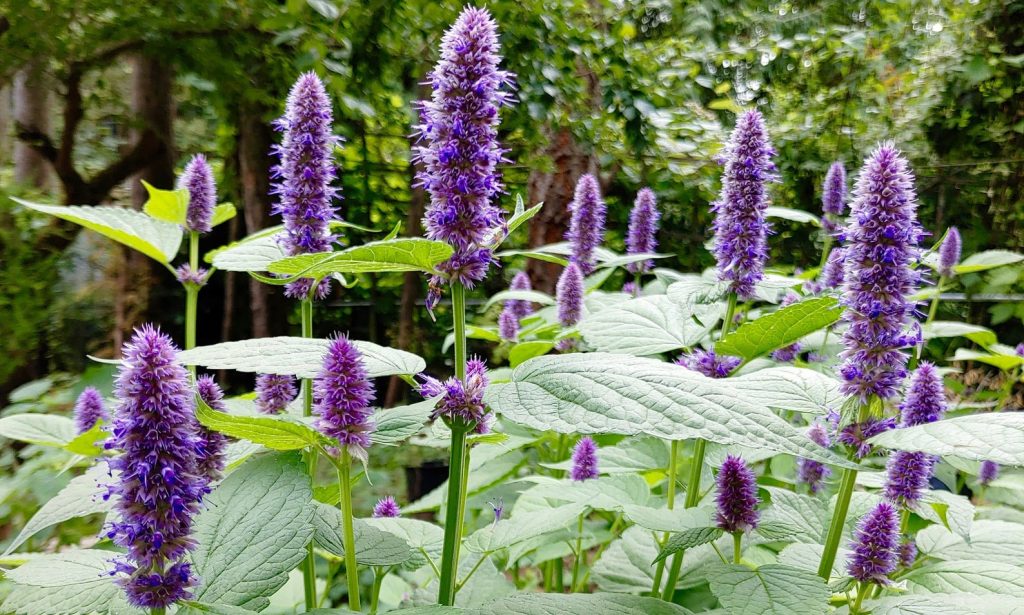
Agastache, pronounced as “ah-GAH-stuh-kee,” refers to aromatic herbaceous perennials encompassing approximately 22 species, with a majority originating from North America. Commonly referred to as “hummingbird mints” and “Giant hyssops,” these plants can also be used to brew herbal tea.
Agastache flowers possess a distinct appeal to hummingbirds due to their prominent presence among the leaves. These flowers, growing in clusters, measure around 3 to 4 inches in length, and their fuzzy appearance is a result of numerous tiny flowers tightly packed together. The vibrant purple and red hues of these flowers act as a magnet for hummingbirds, particularly during their peak bloom in the summer.
Optimal growth of Agastache flowers involves starting them indoors as plants in May, subsequently transplanting them into flower beds during the summer. These plants require full sun exposure and regular watering during their establishment phase. Once established, they display drought tolerance and can thrive with minimal intervention.
Given their desert origins, Agastache plants possess high tolerance for scorching hot days. Once established, they do not necessitate excessive watering, as overwatering may lead to root rot. Providing a sufficient splash of water followed by allowing them to dry out is the recommended approach.
Common Name: Agastache, Hummingbird Mint, Hyssop
Scientific Name: Agastache
Growing Zones: 3 – 10
Sun: Full Sun
Soil: Lean, well-draining soil
Colors: Blue, purple, red, orange, pink, white
Height: 3 – 5 feet tall
Spread: Varies
Plant Type: Herbaceous perennial
4. Morning Glory

The term “Morning Glory” encompasses over 1,000 species of flowering plants within the Convolvulaceae family. These plants are named for their unique characteristic of opening their flowers early in the morning and closing them when the heat of the day intensifies. However, certain species within the Morning Glory family bloom at night rather than during the day, such as Ipomoea alba.
Morning glory flowers exhibit vibrant and colorful blooms, fast-growing vines, bright green foliage, and resilience to poor and dry soils. They are often entwined around arbors or allowed to creep along the exterior walls of houses with the support of trellises.
One notable Morning Glory species renowned for attracting hummingbirds is Ipomoea purpurea. It features bright purple, trumpet-shaped flowers and heart-shaped leaves that unfurl in the morning and close in the afternoon. These flowers bloom from early summer to early fall.
While Morning Glory is considered an annual vine, it may exhibit perennial traits in milder climates. Full sun exposure, up to 8 hours of daily sunlight, is crucial for achieving abundant blooms. It is advisable to plant Morning Glories directly in the desired location, as they do not tolerate transplantation well.
Moreover, caution must be exercised with the fast-growing vines, as they can potentially become invasive. Additionally, the seeds of Morning Glory are toxic if ingested, making it important to prevent children and pets from accessing the plant.
Common Name: Morning Glory, Common Morning Glory
Scientific Name: Convolvulaceae family
Growing Zones: 2 – 11
Sun: Full sun
Soil: Moist, well-draining
Colors: White, pink, purple, blue
Height: 6 – 10 feet tall
Spread: 3 – 6 feet wide
Plant Type: Annual
5. Impatiens
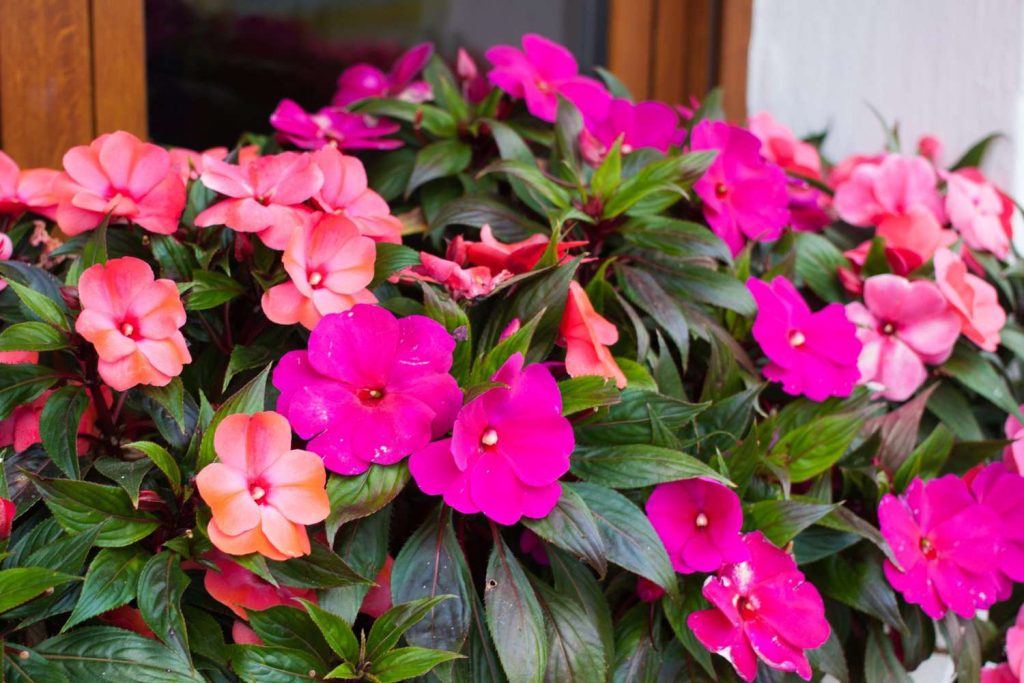
Impatiens, vibrant and colorful annuals, serve as fantastic additions to brighten up shaded areas while also attracting hummingbirds.
These plants thrive in moist and well-draining soil, making them suitable for deep shade environments. Hanging them on a porch can be an effective way to display them and entice hummingbirds.
Impatiens are commonly grown from nursery-bought plants, which are densely planted together to create a lush mat of flowers and foliage. Seeds can also be collected from existing plants and sown indoors approximately 10 weeks before the last frost, as they require ample time to bloom. Cuttings can be taken in the fall and nurtured indoors until the frost subsides.
Common Name: Impatiens, Jewelweed, Touch-me-not, Snapweed, Patience
Scientific Name: Impatiens
Growing Zones: 2 – 11
Sun: Shade or partial shade
Soil: Rich, well-draining
Colors: Red, pink, purple, yellow, coral
Height: 6 – 36 inches
Spread: 1 – 3 feet
Plant Type: Annual
6. Columbine
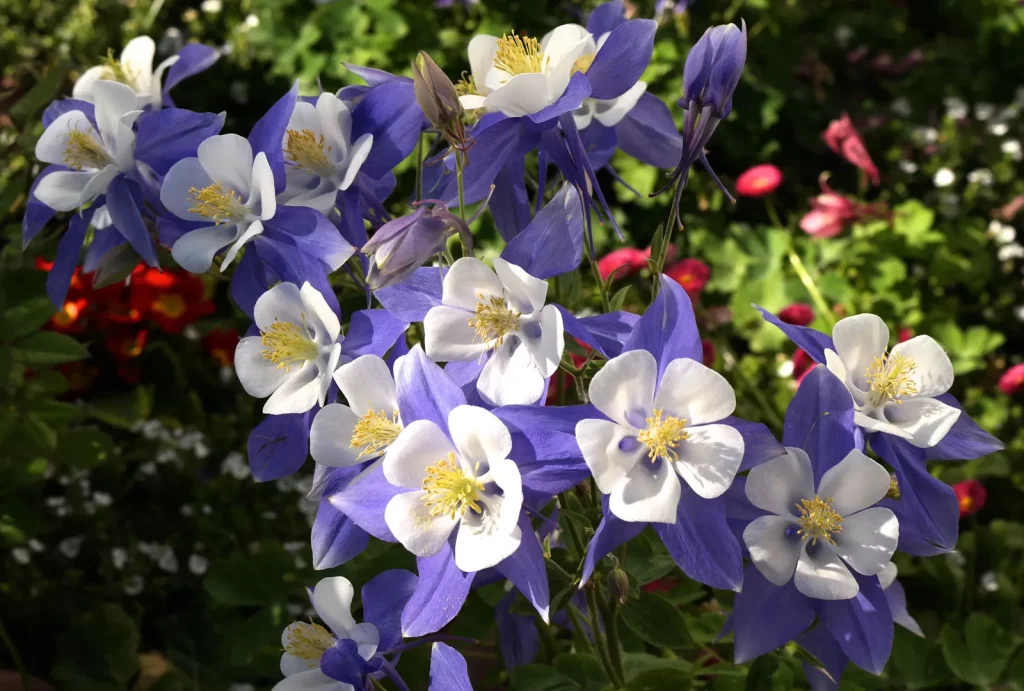
Columbines are among the top choices when it comes to plants that attract hummingbirds due to their vibrant range of colors and ability to thrive in partially shaded areas.
Columbine, scientifically known as Aquilegia, stands out as an elegant perennial plant, boasting spiky bell-shaped blooms measuring 3 to 6 inches in length. These distinctive flowers capture attention and have become synonymous with the term Aquilegia.
Various columbine varieties exist, with most favoring sun to full shade conditions and blooming as early as spring, making them an excellent choice for attracting hummingbirds.
Notably, columbines are not only shade-tolerant but also exhibit resilience against drought and resistance to deer. Sowing columbine seeds directly into the ground during spring allows them to self-seed if left undisturbed after the flowering season. Alternatively, indoor sowing of seeds 6 to 8 weeks before the last frost can provide a head start, although flowers may not appear until the plant’s second year.
Common Name: Columbine, Aquilegia
Scientific Name: Aquilegia
Growing Zones: 3 – 9
Sun: Full sun to partial shade
Soil: Neutral pH, moist but well-draining
Colors: Red, pink, blue, orange, white, yellow
Height: 1 – 3 feet
Spread: 1 foot
Plant Type: Perennial
7. Coneflower
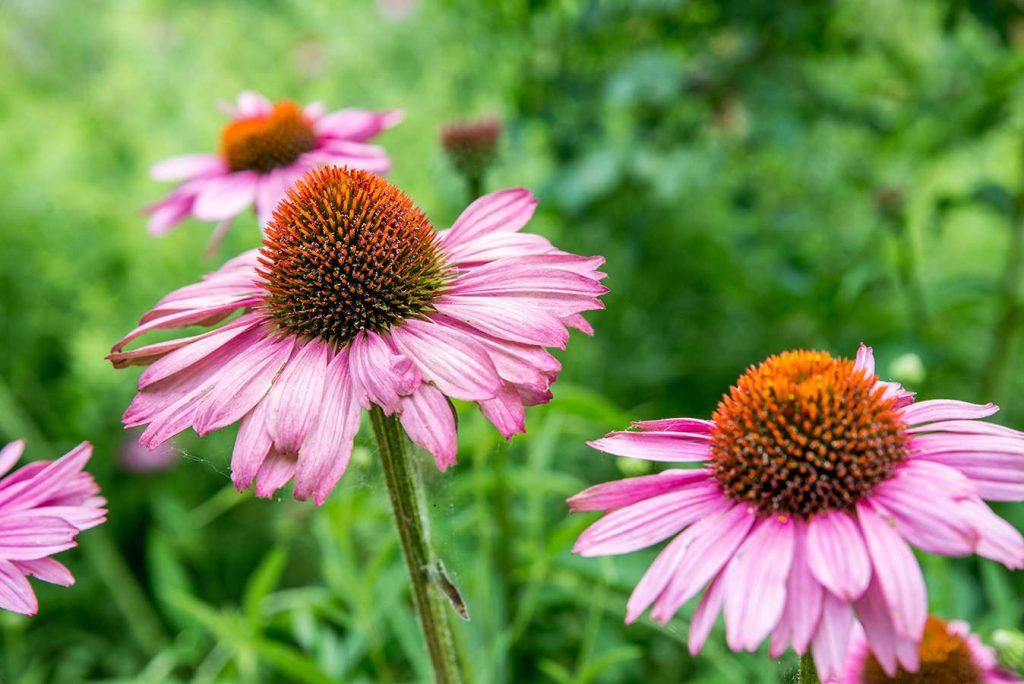
Coneflower, scientifically referred to as Echinacea, represents a common name encompassing a genus of flowering plants within the Asteraceae family, known as the daisy family. The scientific name “Echinacea” derives from Greek, signifying “sea urchin,” in reference to its glossy central disk.
The term “Coneflower” originates from the downward-pointing petals that form a cone-like shape once the central flower head unfolds. Among these coneflowers, Echinacea purpurea, or purple coneflower, prevails as a popular choice for ornamental purposes in backyard settings. This species is native to eastern North America.
Coneflowers showcase large blooms, approximately 6 inches in diameter, atop stalks that can reach heights of 5 feet. Available in a variety of colors, including pink, red, orange, yellow, and white, they thrive under full sun exposure and prefer well-drained soil. These flowers bloom from summer to fall and possess nectar-rich central cones that attract hummingbirds, as well as bees and butterflies.
Common Name: Coneflower
Scientific Name: Echinacea
Growing Zones: 3 – 9
Sun: Full Sun
Soil: Varies
Colors: White, yellow, orange, pink, red, purple, green
Height: 2 – 5 feet tall
Spread: 1 ½ – 2 feet wide
Plant Type: Perennial
8. Penstemon
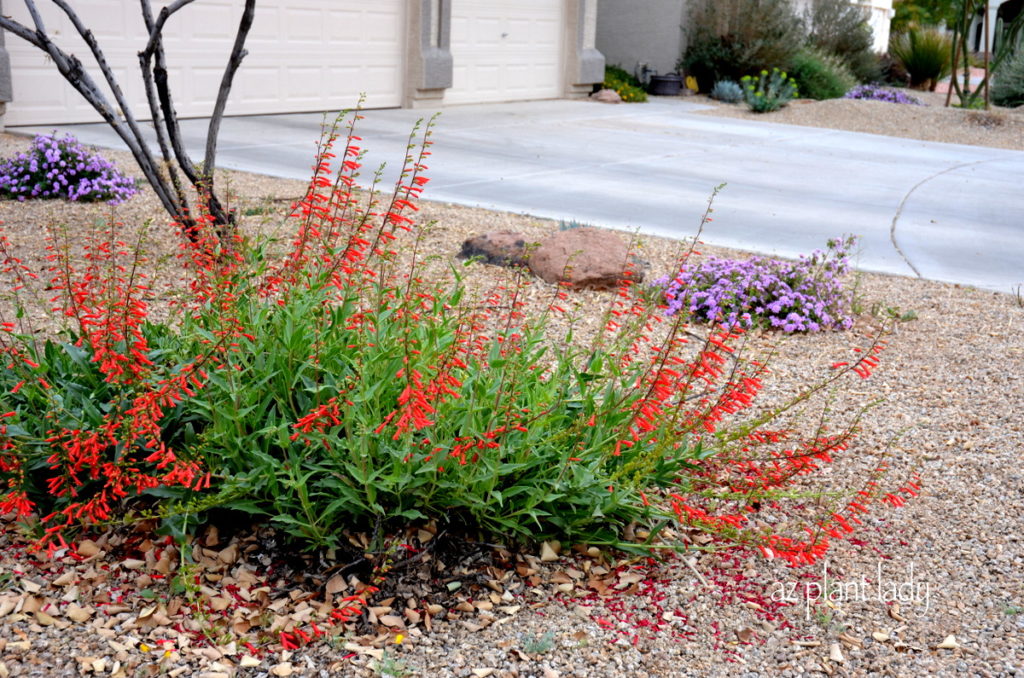
Penstemon, part of the Plantaginaceae family, comprises a genus with over 250 ornamental flowering plants. These plants share characteristics with snapdragons and foxgloves. Penstemon is often referred to as “Beardtongue” due to the tuft of small hairs on the pollen-free stamen protruding from the flowers.
With a wide range of species, Penstemon offers numerous varieties suitable for different backyard settings. Drought tolerance, hummingbird and bee attraction, easy maintenance, and captivating blooms are common traits shared by all Penstemon species, making them an excellent addition to any garden.
Common Name: Penstemon, Foxglove Beard-tongue, Talus Slope Penstemon, White Beardtongue
Scientific Name: Penstemon
Growing Zones: 3 – 9
Sun: Full sun
Soil: Lean, fast-draining soil
Colors: Blue, purple, red, orange, white, pink, yellow
Height: 6 – 12 inches, 1 – 3 feet, 3 – 8 feet
Spread: 8 – 20 inches
Plant Type: Perennial
9. Summersweet
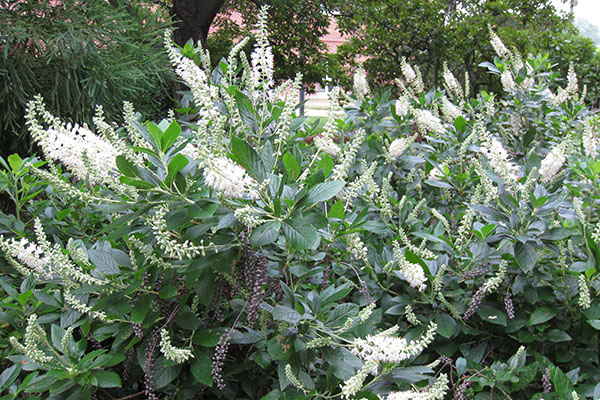
Summersweet, also known as coastal sweet pepperbush, represents a flowering shrub that not only enhances the visual appeal of your backyard but also attracts hummingbirds.
Scientifically known as Clethra alnifolia, this flowering plant belongs to the Clethraceae family and is native to eastern North America. It thrives in various climates, particularly in wetlands and along the edges of ponds and streams.
Summersweet showcases vertical spikes of fragrant white flowers against dark green foliage. During autumn, its green leaves transition to shades of yellow or gold. The name “pepperbush” stems from the brown seed capsules resembling peppercorns that drop after the flowers bloom.
Blooming between July and August, Summersweet flowers measure between 2 to 6 inches in length and are available in white or pink hues. They emit a delightful fragrance that attracts butterflies and hummingbirds, while the pepper-like seeds entice birds during autumn.
Summersweet plants prefer moist to wet soil, making them ideal for their coastal origins. They also thrive in shaded areas. While they tolerate drought, ensuring they receive sufficient hydration during dry spells is essential. Additionally, Summersweet displays tolerance for salty air due to its natural habitat.
To care for Summersweet, provide adequate spacing during planting to accommodate its wide spread. Maintain soil moisture and prune old branches during spring to promote new growth and maintain the desired shape of the shrub.
Common Name: Summersweet, Coastal Sweet Pepperbush
Scientific Name: Clethra alnifolia
Growing Zones: 3 – 9
Sun: Full sun or partial shade
Soil: Moist to wet soil, slightly acidic
Colors: White, pink, rose-colored
Height: 4 – 8 feet tall
Spread: 4 – 6 feet wide
Plant Type: Perennial, Deciduous shrub
10. Yarrow

Yarrow, scientifically known as Achillea millefolium, carries fascinating folklore associated with its name. The term “Achillea” pays homage to the mythical Greek hero Achilles, who was believed to have utilized yarrow for treating his soldiers’ wounds.
Yarrow has also been referred to as “Nosebleed” due to its historical use in both starting and stopping nosebleeds. The name “millefolium” translates to “thousand leaves,” alluding to its finely divided, feather-like foliage.
Common Yarrow, commonly grown in backyard gardens, boasts attractive clusters of tiny flowers available in white, yellow, pink, or red, depending on the specific variant. These clusters comprise 15 to 40 flowers tightly packed on stems.
Yarrow’s foliage adds to its appeal, with evenly distributed feathery leaves along the stem, measuring 2 to 8 inches in length. The larger leaves typically grow near the bottom and middle sections of the plant. Yarrow leaves exude a pleasant aroma and possess a soft, fern-like appearance.
Aside from attracting hummingbirds, bees, and butterflies, Yarrow offers various medicinal uses, including wound and burn treatment, as well as relief from colds, fever, and headaches.
Common Name: Common Yarrow, Milfoil, Nosebleed, Thousand-leaf
Scientific Name: Achillea millefolium
Growing Zones: 3 – 9
Sun: Full sun
Soil: Sandy, loamy, clay, well-draining
Colors: White, yellow, pink, red
Height: 2 – 3 feet tall
Spread: 2 – 3 feet wide
Plant Type: Perennial
11. Bee Balm
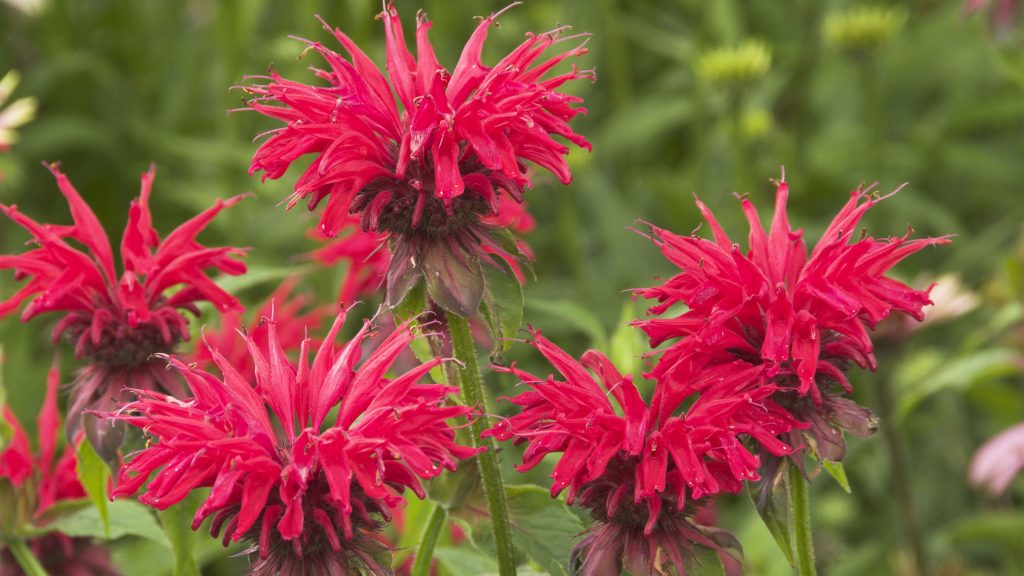
Bee Balm, also known as Monarda, is a flowering plant that not only adds beauty to your garden but also attracts hummingbirds with its vibrant blooms.
Monarda belongs to the mint family (Lamiaceae) and encompasses several species. The flowers of Bee Balm come in various shades, including red, pink, purple, and white. Their tubular shape and nectar-rich qualities make them irresistible to hummingbirds.
These plants thrive in full sun to partial shade conditions and prefer well-drained soil. Regular watering is essential to keep the soil moist but not waterlogged. Additionally, Bee Balm requires adequate air circulation to prevent diseases.
Common Name: Bee Balm, Monarda
Scientific Name: Monarda
Growing Zones: 3 – 9
Sun: Full sun to partial shade
Soil: Well-drained
Colors: Red, pink, purple, white
Height: Varies depending on species
Spread: Varies depending on species
Plant Type: Perennial
12. Cardinal Flower

Cardinal Flower, scientifically known as Lobelia cardinalis, is a stunning perennial plant that attracts hummingbirds with its vibrant red tubular flowers.
Native to North America, Cardinal Flower is named after the bright red robes worn by Catholic cardinals. The flowers grow on tall spikes and provide a striking contrast against their green foliage.
These plants prefer moist, well-draining soil and partial shade to full sun exposure. Cardinal Flower requires consistent watering to maintain soil moisture levels. Planting them near water features or in boggy areas can help create the ideal growing conditions.
Common Name: Cardinal Flower
Scientific Name: Lobelia cardinalis
Growing Zones: 2 – 9
Sun: Partial shade to full sun
Soil: Moist, well-draining
Colors: Red
Height: 2 – 4 feet tall
Spread: 1 – 2 feet wide
Plant Type: Perennial
13. Salvia
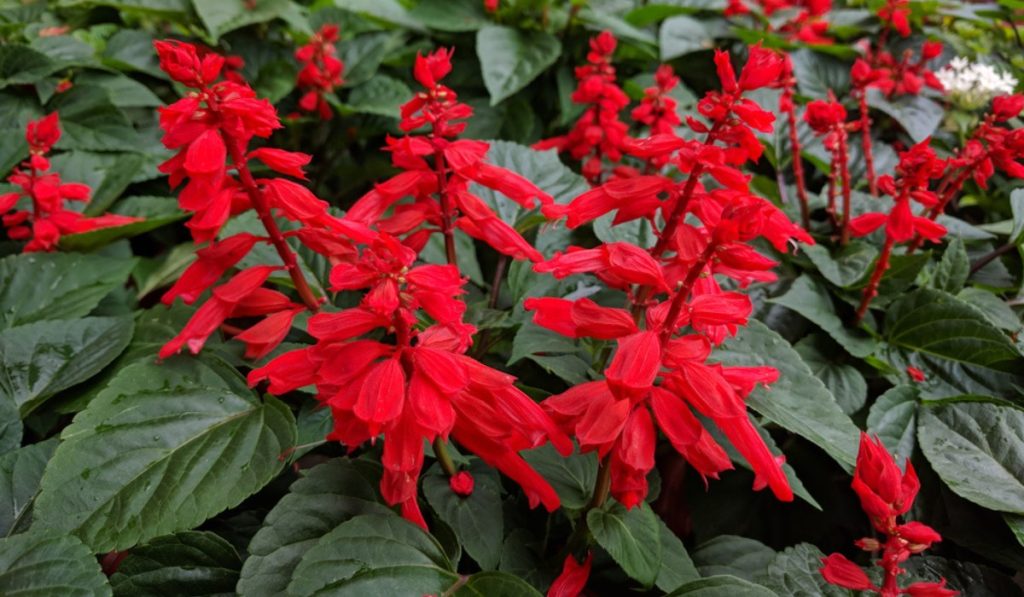
Salvia, commonly known as Sage, is a diverse genus comprising many species, several of which are popular for attracting hummingbirds.
Salvia flowers come in various colors, including shades of blue, purple, red, and pink. The long, tubular shape of the flowers is perfectly suited for hummingbirds’ long beaks.
These plants thrive in full sun and well-drained soil. They are drought-tolerant once established, making them low-maintenance additions to your garden. Pruning after blooming can help promote further growth and blooming.
Common Name: Salvia, Sage
Scientific Name: Salvia
Growing Zones: Varies depending on species
Sun: Full sun
Soil: Well-drained
Colors: Blue, purple, red, pink, and more
Height: Varies depending on species
Spread: Varies depending on species
Plant Type: Perennial
14. Trumpet Vine
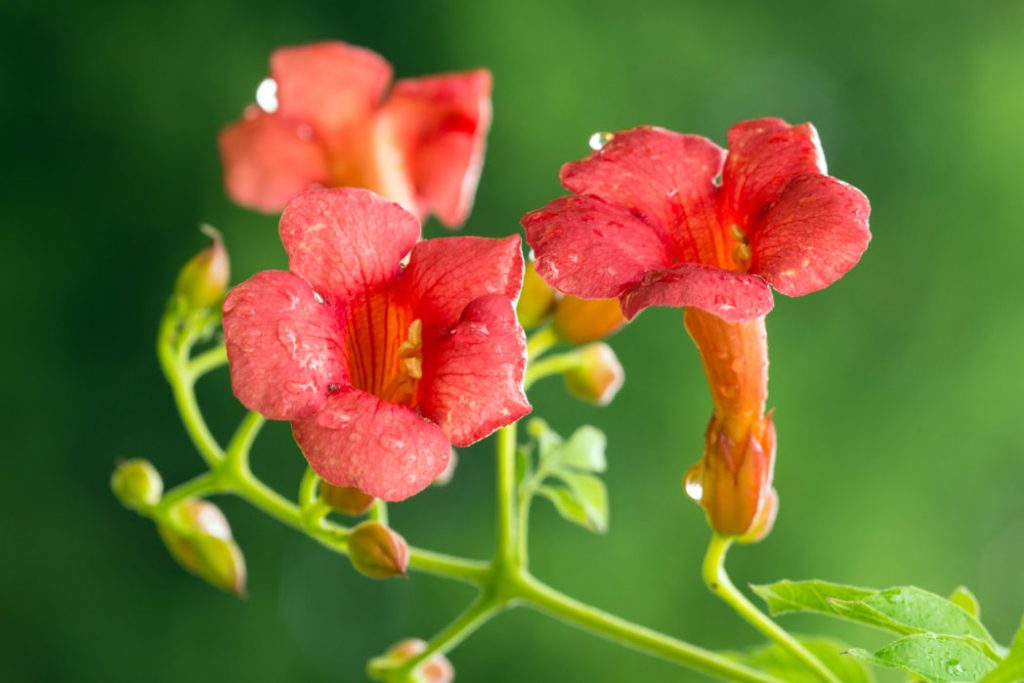
Trumpet Vine, scientifically known as Campsis radicans, is a vigorous, climbing vine that produces large, trumpet-shaped flowers. These bright, fiery orange or red blooms are particularly attractive to hummingbirds.
Native to North America, Trumpet Vine requires sturdy support, such as trellises or arbors, to climb and showcase its flowers. It thrives in full sun exposure and well-drained soil.
While Trumpet Vine can tolerate periods of drought, regular watering during dry spells promotes healthier growth. It’s important to note that this vine can be aggressive and may require pruning to keep it in check.
Common Name: Trumpet Vine
Scientific Name: Campsis radicans
Growing Zones: 4 – 9
Sun: Full sun
Soil: Well-drained
Colors: Orange, red
Height: Up to 30 feet or more
Spread: Can spread vigorously
Plant Type: Vine
15. Coral Bells
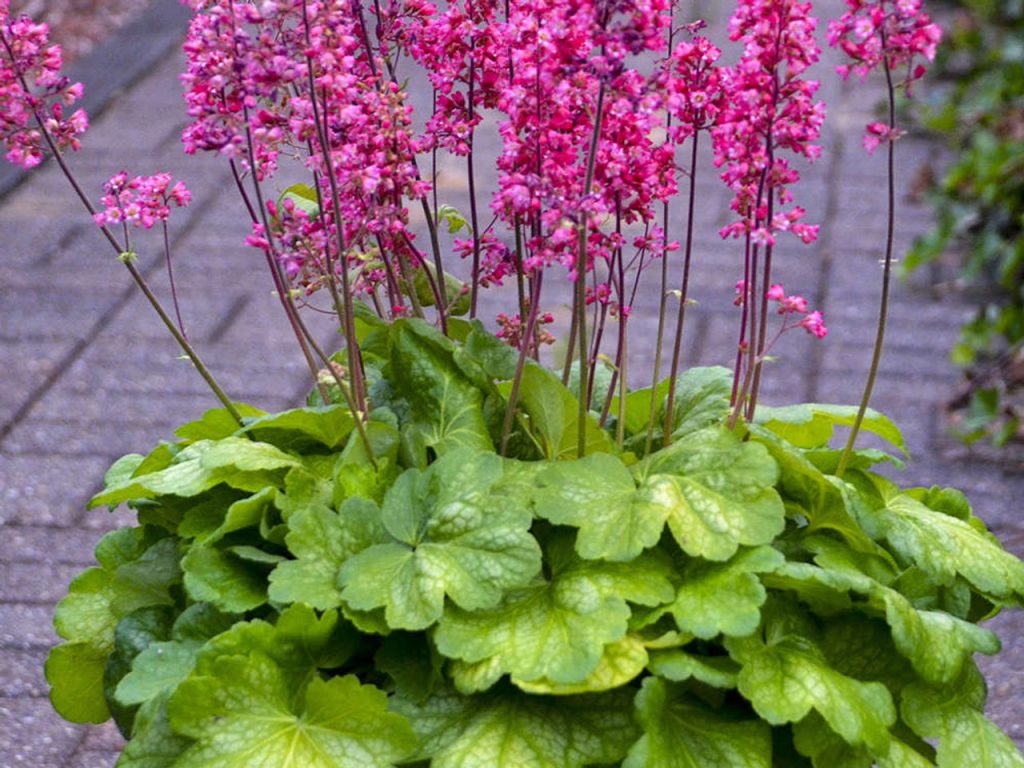
Coral Bells, scientifically known as Heuchera, are herbaceous perennial plants prized for their attractive foliage and delicate bell-shaped flowers. While the flowers may not be as showy as others, the nectar they provide still attracts hummingbirds.
Coral Bells come in a variety of foliage colors, including shades of green, purple, silver, and bronze. They prefer partial shade to full shade conditions and well-drained soil.
Regular watering is necessary to keep the soil moist, especially during dry periods. Removing faded flowers can encourage continuous blooming and prevent self-seeding.
Common Name: Coral Bells
Scientific Name: Heuchera
Growing Zones: Varies depending on species
Sun: Partial shade to full shade
Soil: Well-drained
Colors: Green, purple, silver, bronze, and more
Height: Varies depending on species
Spread: Varies depending on species
Plant Type: Perennial
16. Lantana
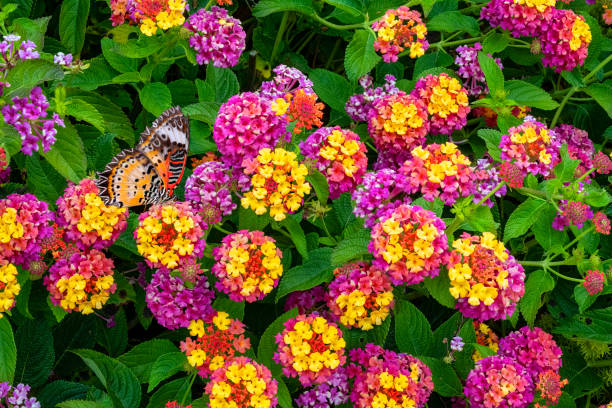
Lantana is a genus of flowering plants that includes both annuals and perennials. These plants are known for their clusters of small, brightly colored flowers, which make them popular among hummingbirds.
Lantana flowers come in a wide range of colors, such as yellow, orange, pink, and red. They thrive in full sun and well-drained soil.
These plants are highly drought-tolerant and can withstand hot and dry conditions. Regular deadheading, or removing faded flowers, can help promote continuous blooming.
Common Name: Lantana
Scientific Name: Lantana
Growing Zones: Varies depending on species
Sun: Full sun
Soil: Well-drained
Colors: Yellow, orange, pink, red, and more
Height: Varies depending on species
Spread: Varies depending on species
Plant Type: Annual or perennial
17. Fuchsia

Fuchsia is a beautiful flowering plant that produces unique, pendulous flowers. These blooms often feature a combination of vibrant colors, including shades of pink, purple, and red, which are highly attractive to hummingbirds.
Fuchsia plants prefer partial shade to full shade conditions and well-drained soil. Regular watering is necessary to keep the soil consistently moist, but they should not be overwatered.
Deadheading faded flowers can help promote continuous blooming throughout the growing season. Pruning in late winter or early spring can help maintain the plant’s shape and encourage new growth.
Common Name: Fuchsia
Scientific Name: Fuchsia
Growing Zones: Varies depending on species
Sun: Partial shade to full shade
Soil: Well-drained
Colors: Pink, purple, red, and more
Height: Varies depending on species
Spread: Varies depending on species
Plant Type: Perennial
18. Butterfly Bush

Butterfly Bush, scientifically known as Buddleja davidii, is a deciduous shrub renowned for its long, cone-shaped clusters of flowers that resemble butterfly wings. These fragrant flowers are not only attractive to butterflies but also to hummingbirds.
Butterfly Bush thrives in full sun and well-drained soil. Regular watering is necessary, particularly during dry periods. Pruning the shrub in early spring helps promote new growth and encourages more blooms.
It’s important to note that Butterfly Bush can be invasive in some regions, so be sure to check its status and choose non-invasive cultivars if necessary.
Common Name: Butterfly Bush
Scientific Name: Buddleja davidii
Growing Zones: 5 – 9
Sun: Full sun
Soil: Well-drained
Colors: Purple, pink, white, and more
Height: 6 – 10 feettall
Spread: 4 – 10 feet wide
Plant Type: Deciduous shrub
19. Bleeding Heart
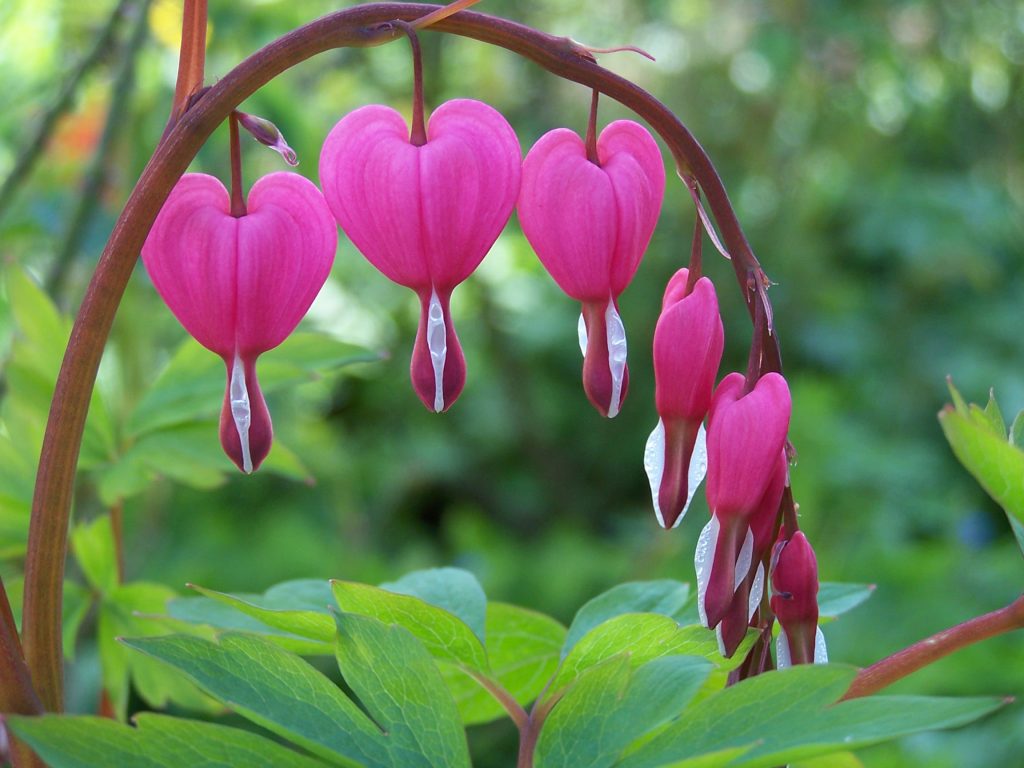
Bleeding Heart, scientifically known as Lamprocapnos spectabilis, is a perennial plant appreciated for its unique heart-shaped flowers. These flowers, typically pink or white, hang gracefully from arching stems and are attractive to hummingbirds.
Bleeding Heart prefers partial shade to full shade conditions and moist, well-drained soil. Regular watering is necessary to maintain soil moisture levels, particularly during dry periods.
The plant goes dormant in summer, so it’s important to provide sufficient mulch to help retain soil moisture and protect the roots. Dividing the plant every few years can help rejuvenate it and promote better flowering.
Common Name: Bleeding Heart
Scientific Name: Lamprocapnos spectabilis
Growing Zones: 3 – 9
Sun: Partial shade to full shade
Soil: Moist, well-drained
Colors: Pink, white
Height: 2 – 4 feet tall
Spread: 2 – 3 feet wide
Plant Type: Perennial
20. Red Hot Poker
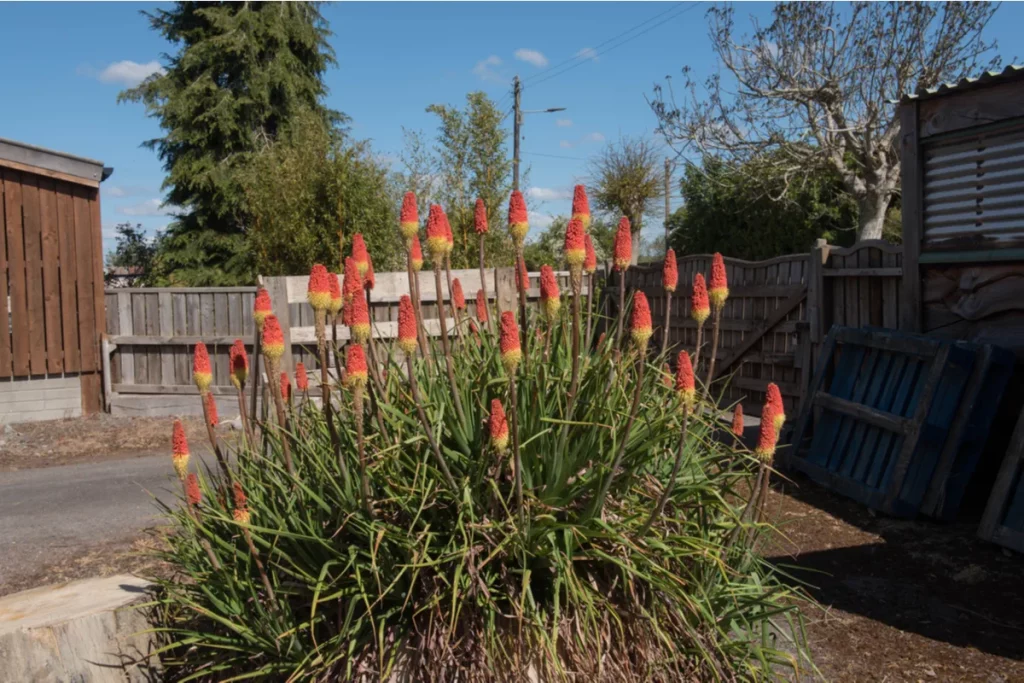
Red Hot Poker, scientifically known as Kniphofia, is a striking perennial plant that produces tall spikes of tubular flowers. These flowers, often in shades of red, orange, and yellow, are a favorite of hummingbirds.
Red Hot Poker thrives in full sun exposure and well-drained soil. Regular watering is necessary, particularly during dry periods. Deadheading faded flowers can help promote continuous blooming.
These plants are known for their tolerance to heat and drought, making them suitable for gardeners in warmer climates.
Common Name: Red Hot Poker
Scientific Name: Kniphofia
Growing Zones: 5 – 9
Sun: Full sun
Soil: Well-drained
Colors: Red, orange, yellow, and more
Height: 2 – 6 feet tall
Spread: 1 – 3 feet wide
Plant Type: Perennial
